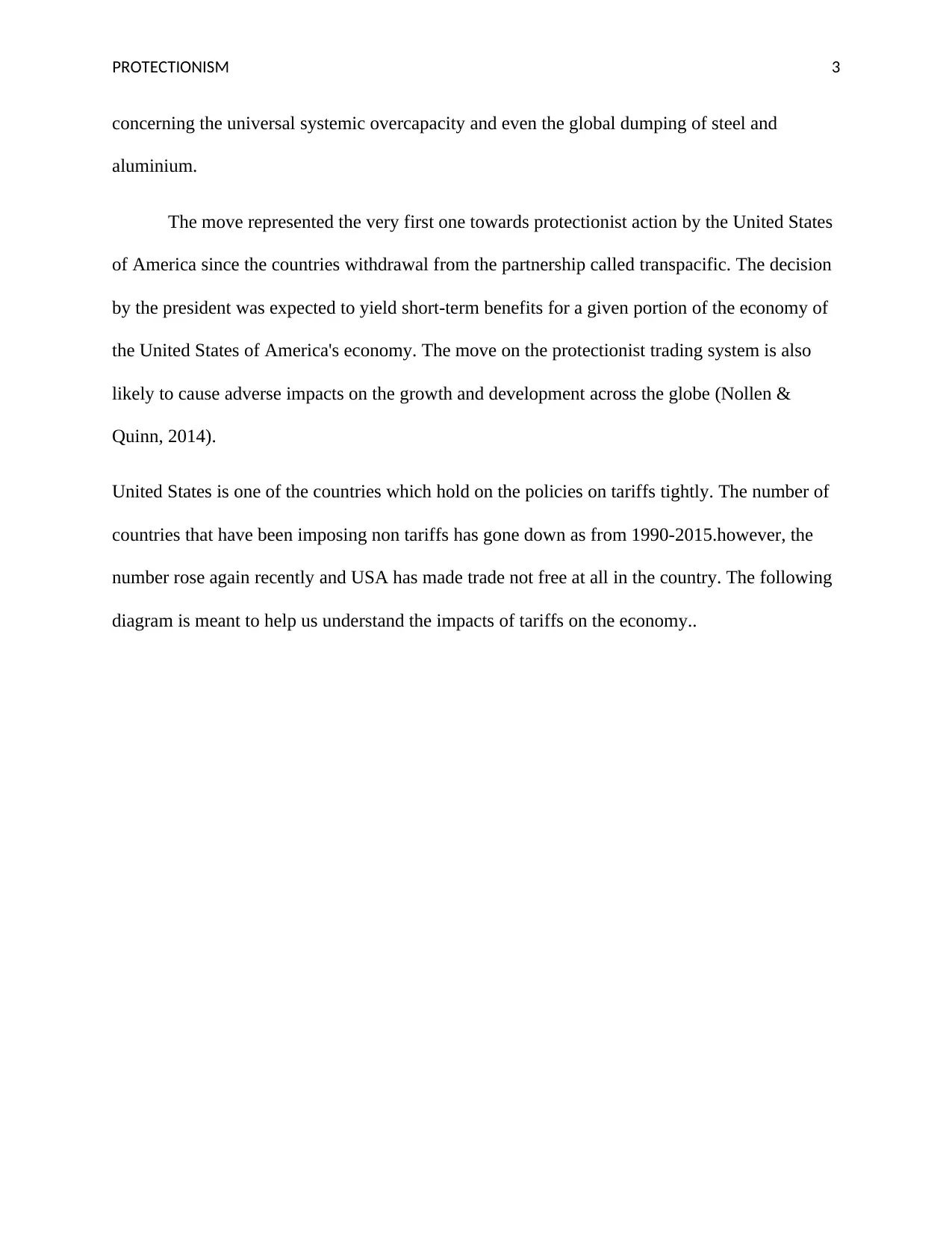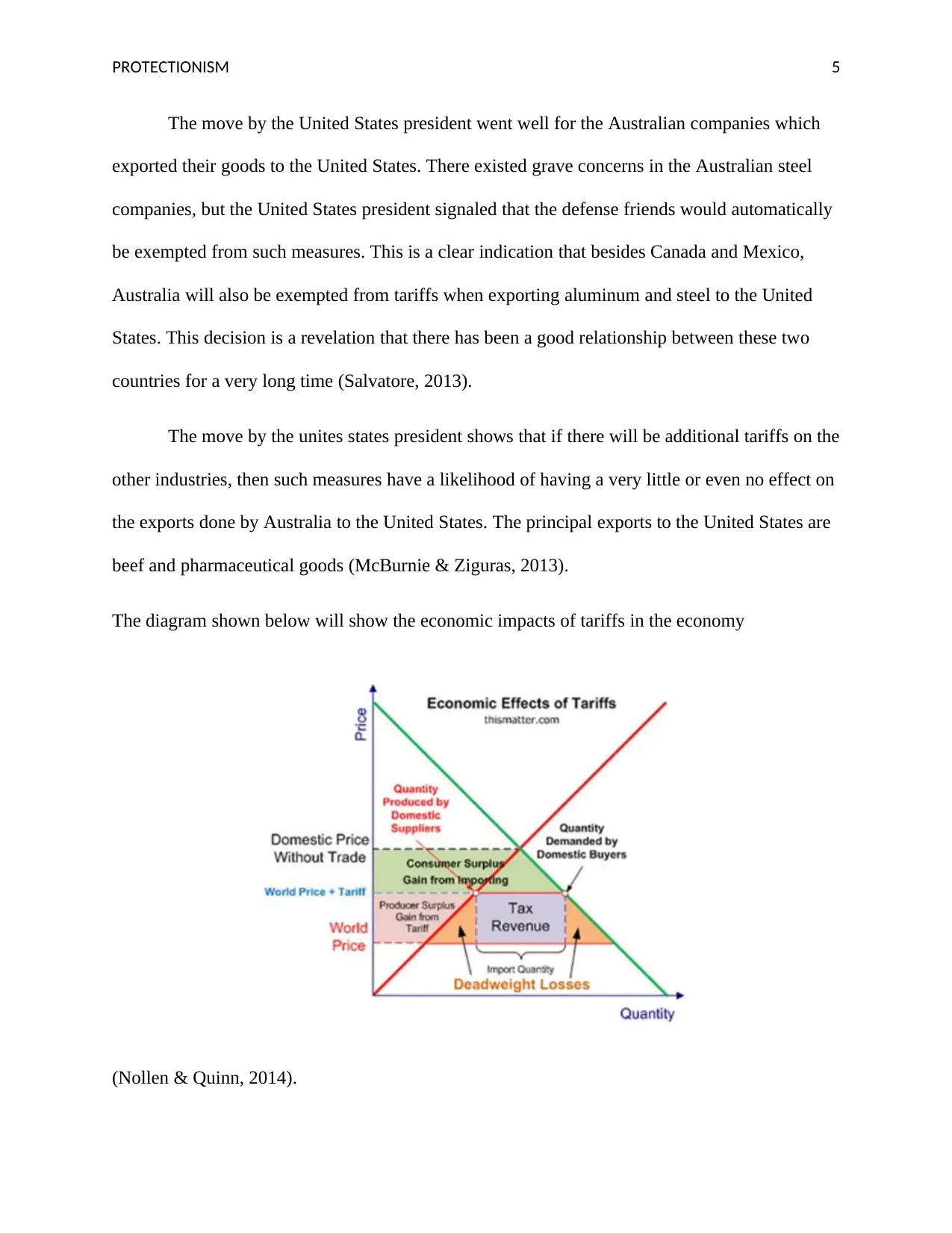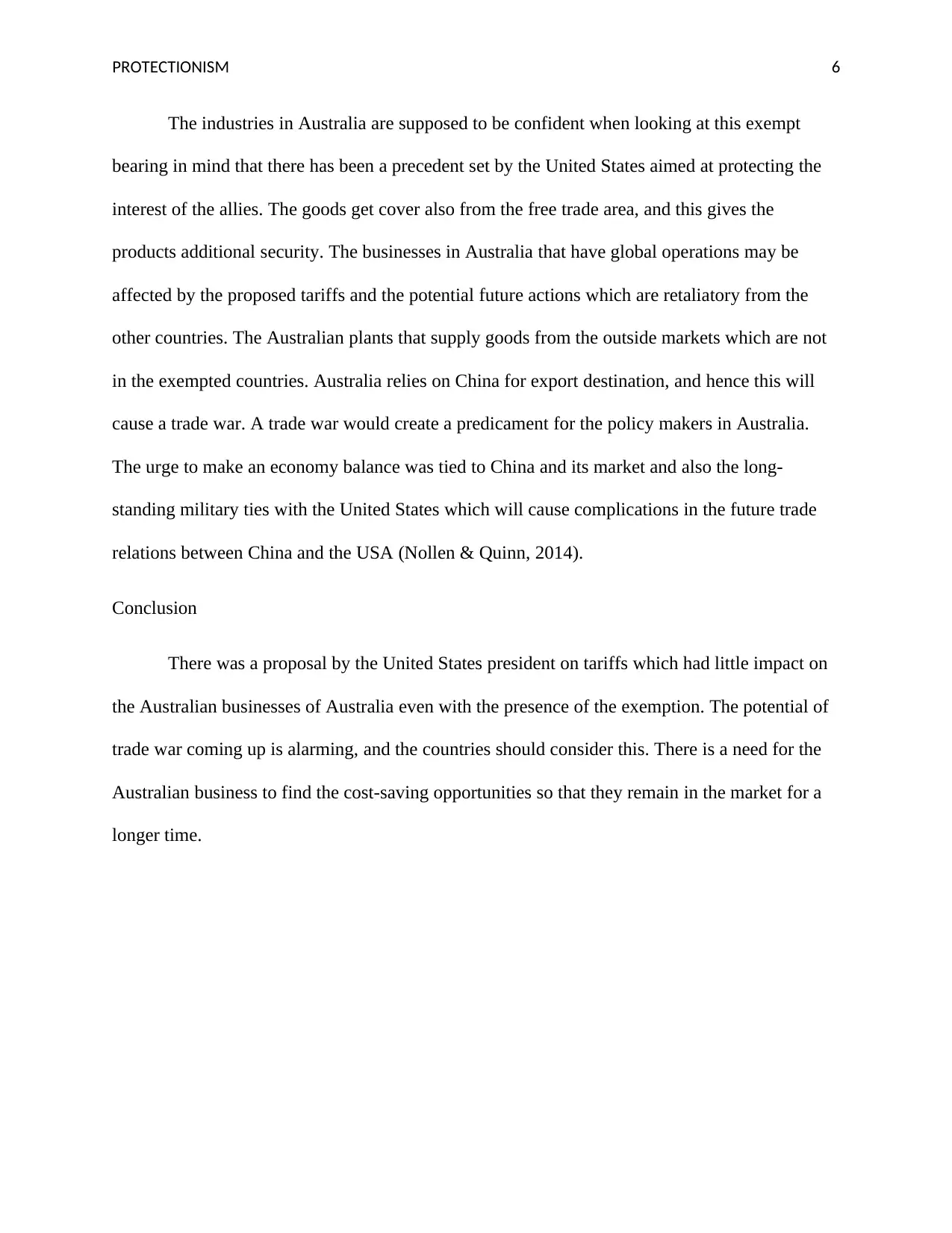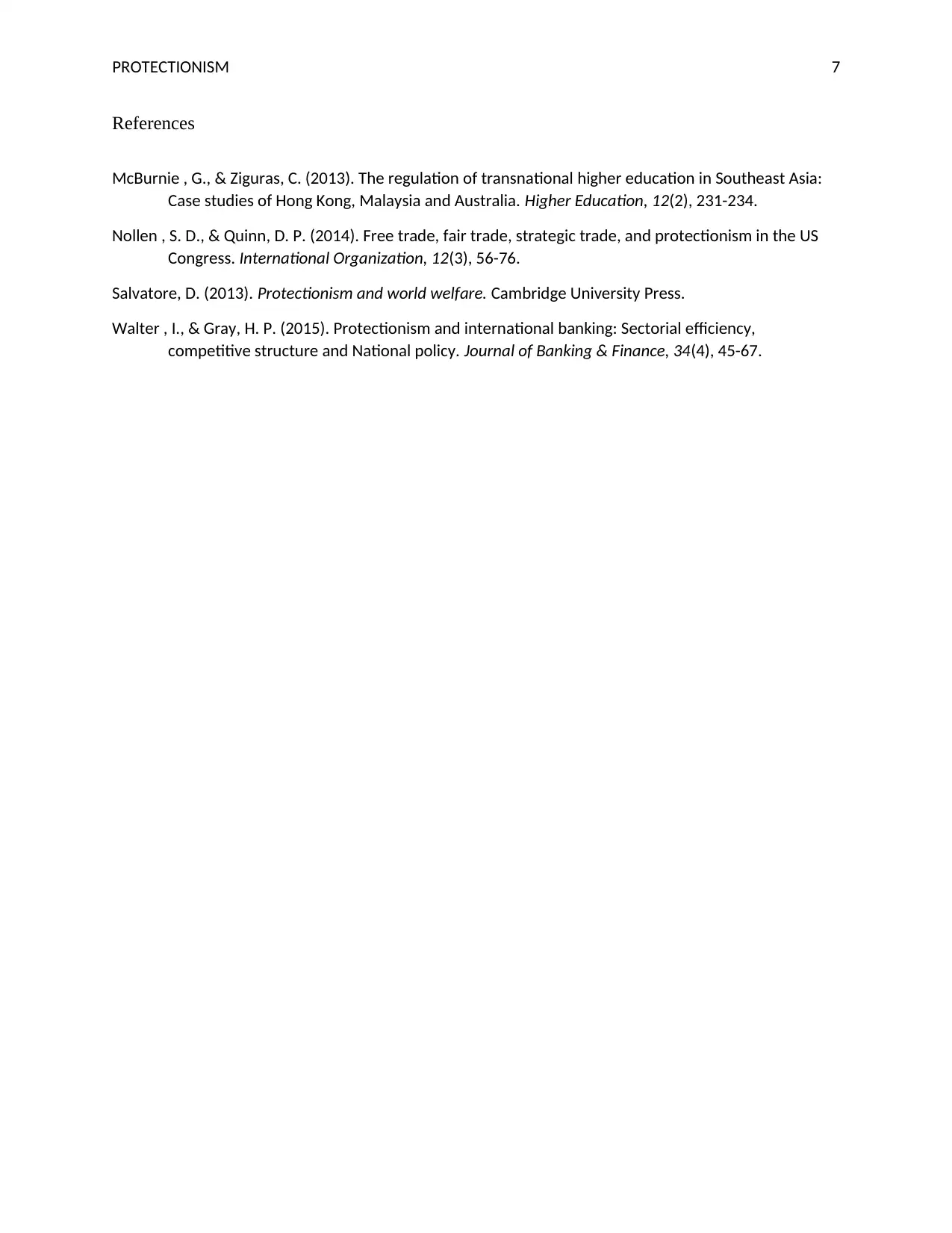Analyzing the Impact of Trump's Protectionist Policies on Australia
VerifiedAdded on 2023/06/04
|7
|1330
|360
Essay
AI Summary
This essay delves into the potential consequences of President Donald Trump's protectionist policies, specifically focusing on the imposition of tariffs on steel and aluminum imports, and its impact on macroeconomic equilibrium in both Australia and the USA. It discusses the rationale behind these policies, including national security concerns and addressing global overcapacity, while also acknowledging the potential for a global trade war. The analysis considers the short-term benefits for specific sectors within the US economy against the adverse effects on global growth and development. The essay further explores the reactions from other countries, such as Canada and China, and highlights Australia's unique position due to its strategic alliance with the USA and its exemption from the tariffs. Ultimately, the essay assesses the implications for Australian businesses, particularly those with global operations, and emphasizes the need for agile supply chain management and diversification to mitigate risks associated with protectionist measures and potential retaliatory actions from other nations.

Running Head: PROTECTIONISM
THE USA PROTECTIONSIM
Name
Professor
Institution
Course
Date
THE USA PROTECTIONSIM
Name
Professor
Institution
Course
Date
Paraphrase This Document
Need a fresh take? Get an instant paraphrase of this document with our AI Paraphraser

PROTECTIONISM 2
President Donald Trump recently proposed a bill to implement a 25% tariff rate on the
importation of steel. He also suggested that aluminium imports should have a 10% tariff. The
latter proposals were in response to a national security recommendation.
However, the exports from Australia (mostly steel and aluminium) will get an exemption
from the tariff that the USA president proposed. The primary factor in the decision on taxes was
the strategic alliance that both the USA and Australia have in common (McBurnie & Ziguras,
2013). The move from President Donald Trump is a vivid indication that given the future
additional tariffs are imposed on the other firms; then there will be a likelihood of a lesser impact
on the exports that the Australian government export to the United States of America.
The tariffs are however known to be a representation of a significant vitality as far as the
global trade policy is concerned. The Australian businesses that have their operations
everywhere around the globe need to assess the supply chains that they operate in and also come
up with development strategies of sourcing to make sure that they are incredibly agile in their
reaction to any additional actions by the United States of America. The latter will come in
addition to the likely retaliatory measures of the countries that are not exempted (Walter & Gray,
2015).
The United States president: President Donald Trump’s announcement that would see the
implementation of a 25% rate of tariff on the importation of steel and a 10% tariff on the import
of Iron ore saw some critics giving out a suggestion that the united states of America were just a
move that would easily drag the entire universe to a potential universal trade war. The decision
was based on the findings that the performance of the United States steel and aluminium
industries posed a great danger to the matters of national security (Salvatore, 2013). The
president’s move to impose tariffs on aluminium and steel was also supposed to address the issue
President Donald Trump recently proposed a bill to implement a 25% tariff rate on the
importation of steel. He also suggested that aluminium imports should have a 10% tariff. The
latter proposals were in response to a national security recommendation.
However, the exports from Australia (mostly steel and aluminium) will get an exemption
from the tariff that the USA president proposed. The primary factor in the decision on taxes was
the strategic alliance that both the USA and Australia have in common (McBurnie & Ziguras,
2013). The move from President Donald Trump is a vivid indication that given the future
additional tariffs are imposed on the other firms; then there will be a likelihood of a lesser impact
on the exports that the Australian government export to the United States of America.
The tariffs are however known to be a representation of a significant vitality as far as the
global trade policy is concerned. The Australian businesses that have their operations
everywhere around the globe need to assess the supply chains that they operate in and also come
up with development strategies of sourcing to make sure that they are incredibly agile in their
reaction to any additional actions by the United States of America. The latter will come in
addition to the likely retaliatory measures of the countries that are not exempted (Walter & Gray,
2015).
The United States president: President Donald Trump’s announcement that would see the
implementation of a 25% rate of tariff on the importation of steel and a 10% tariff on the import
of Iron ore saw some critics giving out a suggestion that the united states of America were just a
move that would easily drag the entire universe to a potential universal trade war. The decision
was based on the findings that the performance of the United States steel and aluminium
industries posed a great danger to the matters of national security (Salvatore, 2013). The
president’s move to impose tariffs on aluminium and steel was also supposed to address the issue

PROTECTIONISM 3
concerning the universal systemic overcapacity and even the global dumping of steel and
aluminium.
The move represented the very first one towards protectionist action by the United States
of America since the countries withdrawal from the partnership called transpacific. The decision
by the president was expected to yield short-term benefits for a given portion of the economy of
the United States of America's economy. The move on the protectionist trading system is also
likely to cause adverse impacts on the growth and development across the globe (Nollen &
Quinn, 2014).
United States is one of the countries which hold on the policies on tariffs tightly. The number of
countries that have been imposing non tariffs has gone down as from 1990-2015.however, the
number rose again recently and USA has made trade not free at all in the country. The following
diagram is meant to help us understand the impacts of tariffs on the economy..
concerning the universal systemic overcapacity and even the global dumping of steel and
aluminium.
The move represented the very first one towards protectionist action by the United States
of America since the countries withdrawal from the partnership called transpacific. The decision
by the president was expected to yield short-term benefits for a given portion of the economy of
the United States of America's economy. The move on the protectionist trading system is also
likely to cause adverse impacts on the growth and development across the globe (Nollen &
Quinn, 2014).
United States is one of the countries which hold on the policies on tariffs tightly. The number of
countries that have been imposing non tariffs has gone down as from 1990-2015.however, the
number rose again recently and USA has made trade not free at all in the country. The following
diagram is meant to help us understand the impacts of tariffs on the economy..
⊘ This is a preview!⊘
Do you want full access?
Subscribe today to unlock all pages.

Trusted by 1+ million students worldwide

PROTECTIONISM 4
(McBurnie & Ziguras, 2013) .
In response to the United States president on the measures, countries like Canada and
Europe issued a threat to hit back with an exact test of the significant imports done by the United
States of America. Despite this, Canada had for a very long time been exempted by the United
States from the measures put by the president. The matter on the exemption of Canada was to be
kept pending until the next negotiations for the North American Free Trade Area (NAFTA)
(Nollen & Quinn, 2014). There were also hopes that came from China and whose central purpose
was to exercise restraint for the sake of continued growth and development of the economy
which was known to go with the liberalization of trade mostly because aluminum and steel
exports accounted for just a mere 0.03% of the gross domestic product. China had given a
promise to react to these tariffs, and this remained clear for some time (McBurnie & Ziguras,
2013).
(McBurnie & Ziguras, 2013) .
In response to the United States president on the measures, countries like Canada and
Europe issued a threat to hit back with an exact test of the significant imports done by the United
States of America. Despite this, Canada had for a very long time been exempted by the United
States from the measures put by the president. The matter on the exemption of Canada was to be
kept pending until the next negotiations for the North American Free Trade Area (NAFTA)
(Nollen & Quinn, 2014). There were also hopes that came from China and whose central purpose
was to exercise restraint for the sake of continued growth and development of the economy
which was known to go with the liberalization of trade mostly because aluminum and steel
exports accounted for just a mere 0.03% of the gross domestic product. China had given a
promise to react to these tariffs, and this remained clear for some time (McBurnie & Ziguras,
2013).
Paraphrase This Document
Need a fresh take? Get an instant paraphrase of this document with our AI Paraphraser

PROTECTIONISM 5
The move by the United States president went well for the Australian companies which
exported their goods to the United States. There existed grave concerns in the Australian steel
companies, but the United States president signaled that the defense friends would automatically
be exempted from such measures. This is a clear indication that besides Canada and Mexico,
Australia will also be exempted from tariffs when exporting aluminum and steel to the United
States. This decision is a revelation that there has been a good relationship between these two
countries for a very long time (Salvatore, 2013).
The move by the unites states president shows that if there will be additional tariffs on the
other industries, then such measures have a likelihood of having a very little or even no effect on
the exports done by Australia to the United States. The principal exports to the United States are
beef and pharmaceutical goods (McBurnie & Ziguras, 2013).
The diagram shown below will show the economic impacts of tariffs in the economy
(Nollen & Quinn, 2014).
The move by the United States president went well for the Australian companies which
exported their goods to the United States. There existed grave concerns in the Australian steel
companies, but the United States president signaled that the defense friends would automatically
be exempted from such measures. This is a clear indication that besides Canada and Mexico,
Australia will also be exempted from tariffs when exporting aluminum and steel to the United
States. This decision is a revelation that there has been a good relationship between these two
countries for a very long time (Salvatore, 2013).
The move by the unites states president shows that if there will be additional tariffs on the
other industries, then such measures have a likelihood of having a very little or even no effect on
the exports done by Australia to the United States. The principal exports to the United States are
beef and pharmaceutical goods (McBurnie & Ziguras, 2013).
The diagram shown below will show the economic impacts of tariffs in the economy
(Nollen & Quinn, 2014).

PROTECTIONISM 6
The industries in Australia are supposed to be confident when looking at this exempt
bearing in mind that there has been a precedent set by the United States aimed at protecting the
interest of the allies. The goods get cover also from the free trade area, and this gives the
products additional security. The businesses in Australia that have global operations may be
affected by the proposed tariffs and the potential future actions which are retaliatory from the
other countries. The Australian plants that supply goods from the outside markets which are not
in the exempted countries. Australia relies on China for export destination, and hence this will
cause a trade war. A trade war would create a predicament for the policy makers in Australia.
The urge to make an economy balance was tied to China and its market and also the long-
standing military ties with the United States which will cause complications in the future trade
relations between China and the USA (Nollen & Quinn, 2014).
Conclusion
There was a proposal by the United States president on tariffs which had little impact on
the Australian businesses of Australia even with the presence of the exemption. The potential of
trade war coming up is alarming, and the countries should consider this. There is a need for the
Australian business to find the cost-saving opportunities so that they remain in the market for a
longer time.
The industries in Australia are supposed to be confident when looking at this exempt
bearing in mind that there has been a precedent set by the United States aimed at protecting the
interest of the allies. The goods get cover also from the free trade area, and this gives the
products additional security. The businesses in Australia that have global operations may be
affected by the proposed tariffs and the potential future actions which are retaliatory from the
other countries. The Australian plants that supply goods from the outside markets which are not
in the exempted countries. Australia relies on China for export destination, and hence this will
cause a trade war. A trade war would create a predicament for the policy makers in Australia.
The urge to make an economy balance was tied to China and its market and also the long-
standing military ties with the United States which will cause complications in the future trade
relations between China and the USA (Nollen & Quinn, 2014).
Conclusion
There was a proposal by the United States president on tariffs which had little impact on
the Australian businesses of Australia even with the presence of the exemption. The potential of
trade war coming up is alarming, and the countries should consider this. There is a need for the
Australian business to find the cost-saving opportunities so that they remain in the market for a
longer time.
⊘ This is a preview!⊘
Do you want full access?
Subscribe today to unlock all pages.

Trusted by 1+ million students worldwide

PROTECTIONISM 7
References
McBurnie , G., & Ziguras, C. (2013). The regulation of transnational higher education in Southeast Asia:
Case studies of Hong Kong, Malaysia and Australia. Higher Education, 12(2), 231-234.
Nollen , S. D., & Quinn, D. P. (2014). Free trade, fair trade, strategic trade, and protectionism in the US
Congress. International Organization, 12(3), 56-76.
Salvatore, D. (2013). Protectionism and world welfare. Cambridge University Press.
Walter , I., & Gray, H. P. (2015). Protectionism and international banking: Sectorial efficiency,
competitive structure and National policy. Journal of Banking & Finance, 34(4), 45-67.
References
McBurnie , G., & Ziguras, C. (2013). The regulation of transnational higher education in Southeast Asia:
Case studies of Hong Kong, Malaysia and Australia. Higher Education, 12(2), 231-234.
Nollen , S. D., & Quinn, D. P. (2014). Free trade, fair trade, strategic trade, and protectionism in the US
Congress. International Organization, 12(3), 56-76.
Salvatore, D. (2013). Protectionism and world welfare. Cambridge University Press.
Walter , I., & Gray, H. P. (2015). Protectionism and international banking: Sectorial efficiency,
competitive structure and National policy. Journal of Banking & Finance, 34(4), 45-67.
1 out of 7
Related Documents
Your All-in-One AI-Powered Toolkit for Academic Success.
+13062052269
info@desklib.com
Available 24*7 on WhatsApp / Email
![[object Object]](/_next/static/media/star-bottom.7253800d.svg)
Unlock your academic potential
Copyright © 2020–2025 A2Z Services. All Rights Reserved. Developed and managed by ZUCOL.




